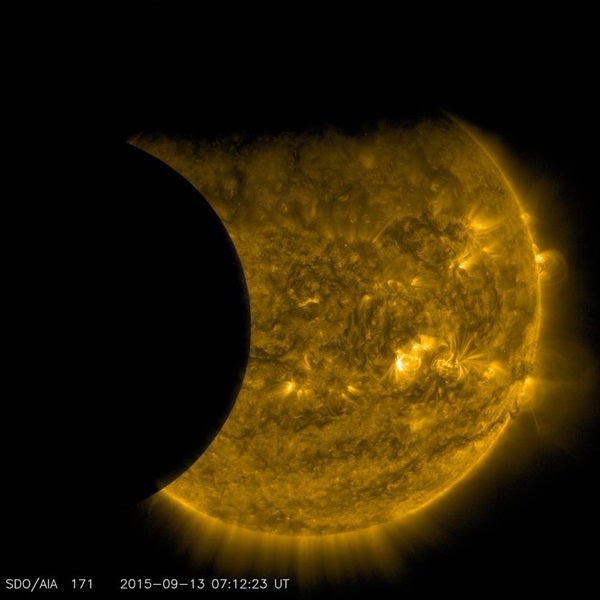NASA’s Solar Dynamics Observatory captured images of Earth and the Moon as they crossed the Sun’s bright face. Just before the Moon entered the shot, Earth blocked SDO’s view completely. By the time SDO had a clear view again, the Moon was just completing its journey across the Sun’s face. // Credits: NASA Goddard’s Scientific Visualization Studio/SDO
On September 13, 2015, as NASA’s Solar Dynamics Observatory (SDO) kept up its constant watch on the Sun, its view was photobombed not once, but twice. Just as the Moon came into SDO’s field of view on a path to cross the Sun, Earth entered the picture, blocking SDO’s view completely. When SDO’s view of the Sun emerged from Earth’s shadow, the Moon was just completing its journey across the Sun’s face.
Though SDO sees dozens of Earth eclipses and several lunar transits each year, this is the first time ever that the two have coincided. This alignment of the Sun, Moon, and Earth also resulted in a partial solar eclipse on September 13, visible only from parts of Africa and Antarctica.
SDO’s orbit usually gives us unobstructed views of the Sun, but Earth’s revolution around the Sun means that SDO’s orbit passes behind Earth twice each year for two to three weeks at a time. During these phases, Earth blocks SDO’s view of the Sun for anywhere from a few minutes to over an hour once each day.
NASA’s Solar Dynamics Observatory captured this image of Earth and the Moon transiting the Sun together on September 13, 2015. The edge of Earth, visible near the top of the frame, appears fuzzy because Earth’s atmosphere blocks different amounts of light at different altitudes. On the left, the Moon’s edge is perfectly crisp because it has no atmosphere. This image was taken in extreme ultraviolet wavelengths of 171 angstroms. Though this light is invisible to our eyes, it is typically colorized in gold.
NASA/SDO










